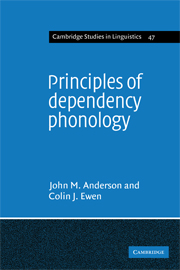Introduction
Published online by Cambridge University Press: 04 August 2010
Summary
In the pages that follow we set out some of the motivations for a view of phonological structure which is in certain respects somewhat novel, particularly in the context of major theoretical developments in the last two decades. Specifically, we shall outline a conception of phonological representation which involves an enrichment of, and a greater variety in, the structural relations that can hold between the atoms of a phonological structure. This enrichment, we shall argue, will enable us both to delimit more narrowly the class of possible phonological regularities and to characterise the relative ‘markedness’ (or potentiality for recurrence) of such regularities.
Our major concern, therefore, will be to pursue the consequences for phonological notation of the observed recurrence of certain groupings of elements and of certain relationships or rules in the phonologies of different languages – on the assumption that the existence of just such recurrences should be predictable from the character of the notation. These recurrences and the characterising notation are assumed to have a natural – i.e. phonetic – basis; thus, as well as optimising the expression of recurrent regularities, the structures allowed for by the phonological notation should, at the very least, not be incompatible with what can be established concerning the nature of the speaker/hearer' production and perception. We hope that, as our understanding sharpens, the relationship between notation and production/perception will be made more determinate.
- Type
- Chapter
- Information
- Principles of Dependency Phonology , pp. 1 - 4Publisher: Cambridge University PressPrint publication year: 1987
- 1
- Cited by



